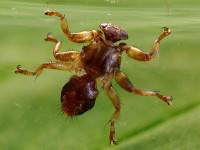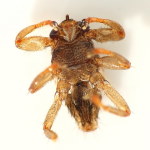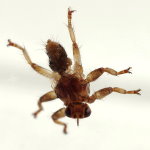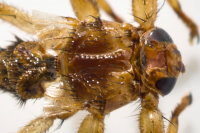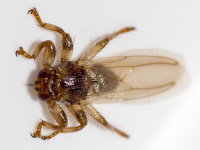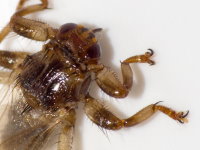Phylum Arthropoda (Arthropods) ➔ Subphylum Hexapoda (Hexapods) ➔ Class Insecta (Insects) ➔ Order Diptera (True flies) ➔ Family Hippoboscidae (Louse flies, keds)
Lipoptena cervi (Linnaeus, 1758)
Hirschlausfliege Deer Ked
Synonyms and other combinations:
Haemobora pallipes Curtis, 1824 | Hippobosca cervi Olivier, 1792 | Hippobosca cervina Nitzsch, 1818 | Hippobosca moschi Pallas, 1779 | Lipoptena alcis Schnabl, 1881 | Lipoptena subulata Coquillett, 1907 | Melophagus trifasciata Olfers, 1816 | Ornithobia pallida Meigen, 1830 | Ornithomyia nigrirostris Roser, 1840 | Pediculus capreoli Olfers, 1816 |
Classification:
Lipoptena cervi belongs to the subfamily Lipopteninae.Distribution:
Widespread in the temperate zones of Europe, Siberia and northern China, introduced to North America.Habitat:
Forests and their immediate surroundings.Description:
5 - 6 mm large, very flat, brown fly with fully developed 5 - 6 mm long wings. A similar species occurring in Germany is the smaller Lipoptena fortisetosa. This should be not so frequent, is significantly smaller and begins to fly earlier in the year (from the end of May/June).Biology:
The Deer Ked is an ectoparasite of deer and other mammals, such as badgers, foxes or wild boars. Lipoptena cervi is viviparous. A female can produce larvae for about 10 months, in total approximately 20 - 25 pieces. A single larva develops in the uterus of the female, which is born as a prepupa. The white prepupa turns dark and pupates at the forest floor. After leaving the puparium, the winged adult looks for a suitable host. As soon as the fly finds one, it clings to the host, looks for a suitable place for a meal and drops the wings. Both males and females suck blood from the host. The flies live and mate on the host.Note:
In late summer and autumn, around mid-August, the Deer Keds can become very annoying during a walk in the forest. According to my impression they have multiplied in the last years (at least in my photo hunting grounds Harthwald and Hutholz).The extent to which they can be considered as transmitters of diseases to humans is the subject of scientific research. Lipoptena cervi is a vector of different species of bacteria of the genus Bartonella.
References, further reading, links:
- Pape T. & Thompson F.C. (eds) (2017). Systema Dipterorum (version 2.0, Jan 2011). In: Species 2000 & ITIS Catalogue of Life, 2017 Annual Checklist (Roskov Y., Abucay L., Orrell T., Nicolson D., Bailly N., Kirk P.M., Bourgoin T., DeWalt R.E., Decock W., De Wever A., Nieukerken E. van, Zarucchi J., Penev L., eds.). Digital resource at www.catalogueoflife.org/annual-checklist/2017. Species 2000: Naturalis, Leiden, the Netherlands. ISSN 2405-884X.
- B. Buss, C.B. Kearnery, C. Coleman, J.D. Henning: Detection of Lyme disease and anaplasmosis pathogens via PCR in Pennsylvania deer ked, Journal of Vector Ecology 41 (2): 292-294, December 2016
- Duodu, S., Madslien, K., Hjelm, E., Molin, Y., Paziewska-Harris, A., Harris, P. D., Colquhoun, D. J., Ytrehus, B. (2013). Bartonella Infections in Deer Keds (Lipoptena cervi) and Moose (Alces alces) in Norway. Applied and Environmental Microbiology, 79(1), 322–327. http://doi.org/10.1128/AEM.02632-12
- Online-Key: Northwestern European Hippoboscidae
